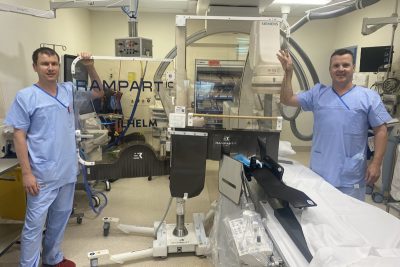Radiation shield provides greater protection to staff
The research trial of a new shield aimed at reducing radiation exposure to staff during cardiac x-rays has shown benefits in providing much greater protection.

Dr Rustem Dautov and Jim Crowhurst with the new Rampart radiation shield which is reducing radiation exposure for staff during cardiac angiography procedures
In an Australian first, the Rampart shielding solution was introduced to The Prince Charles Hospital (TPCH) catheter laboratory to test whether a more substantial radiation protection shield could help reduce the level of radiation exposure to staff performing cardiac angiogram x-rays.
Cardiac angiography remains the primary method to diagnose and treat coronary disease, the leading cause of death in Australia.
As Queensland’s leading cardiac centre, TPCH performs approximately 4,000 cardiac angiograms each year.
Radiographer Clinical Consultant Jim Crowhurst said that during cardiac angiograms, the cardiologist stands close to the patient whilst x-ray images are taken of the heart.
“Having close physical proximity to patients during x-rays can increase radiation exposure to the treating clinician which has known health risks,” Jim said.
“Traditionally staff working in this environment wear led aprons to protect their bodies from the radiation. However, these aprons are heavy and can lead to physical discomfort, especially when worn for long periods. Also, they don’t protect the entire body.”
In the trial, cardiac angiograms were performed on 100 patients using either the traditional led apron shielding or the new Rampart shielding.
Using a special digital dosemeter, measurements of cardiologists’ and scrub nurses’ radiation exposure were taken at several locations on the body.
Results demonstrated that the Rampart shielding significantly reduces radiation exposure to all staff who stand behind the shield. For the treating cardiologist, the x-ray exposure was reduced by 80% to the head, 86% at the collar, 100% at the waist and it was halved at the ankle.
“The reduction in radiation exposure resulting from the use of the Rampart shield is now so low, there is even a potential for staff to remove the heavy lead aprons, which is major change in practice,” Jim said.
“Not only does the shield provide reduced radiation exposure to staff, it also has the potential to allow staff to have greater physical comfort while performing life-saving procedures on patients.
“While our primary focus is improving outcomes for our patients, looking after our staff is important and this initiative highlights how we are investing in our staff’s future health and wellbeing.”
The Rampart is now part of routine practice at TPCH, particularly for longer procedures where radiation exposure is higher.
